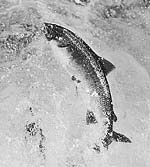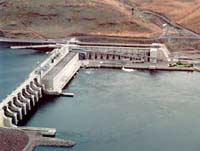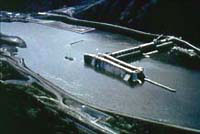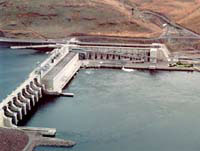Passions run high in the Pacific Northwest over whether to remove four large federal dams on the lower Snake River to recover the river’s imperiled wild salmon and steelhead (a.k.a. sea-run rainbow trout). The Snake once produced more salmon and steelhead than any other river in the vast Columbia River basin — over 2 million fish every year. Most of those fish were large, powerful Chinook salmon that spawned in the numerous Snake River tributaries. Today, the four remaining salmon and steelhead stocks are in steep decline and headed toward extinction.

Running on empty.
Photo: Save Our Wild Salmon.
Now the same federal agencies that boast a 25-year record of failure on the Snake River are once again claiming that it is possible to recover salmon while maintaining the lower Snake River dams. Coming from the Army Corps of Engineers, which operates the dams, this claim should surprise no one. Deeply disturbing, however, is that the government agency charged with recovering salmon, the National Marine Fisheries Service, turned its back on science this summer and joined the chorus opposing dam removal.
Ill Logic Yields Flip-Flop
In July, NMFS issued a draft biological opinion, as required by the Endangered Species Act, articulating its preliminary decision to delay the removal of the dams for nearly 15 years. The agency proposes instead to rely on largely unidentified actions to achieve recovery. This decision flies in the face of reams of scientific information — including analysis by the agency’s own scientists — supporting dam removal. Science indicates that the risk of extinction is alarmingly high; that recovery to self-sustaining, harvestable levels as required by law will require gains well in excess of those needed merely to avert extinction; and that a recovery plan which does not include dam removal is likely to fail.

Dam-ing evidence: Little Goose Dam on the lower Snake.
Photo: Save Our Wild Salmon.
Although a recent article in Science by several NMFS scientists suggested that dam removal may be unnecessary, the authors’ case is predicated on the faulty assumption that first-year survival can be substantially improved by other means. Simply put, no other means have been identified — let alone found feasible — that would yield the necessary improvements. For this reason, the Oregon, Idaho, and Western Division chapters of the American Fisheries Society — the nation’s preeminent professional organization of fisheries scientists — have passed resolutions stating that removal of the four lower Snake River dams is essential to recover Snake River stocks.
Its public message to the contrary notwithstanding, NMFS understands that its draft plan won’t work. In November, the Portland Oregonian uncovered a May 18 draft of the biological opinion that had not been made available to the public. In this document, NMFS called for completing dam removal planning in three years and seeking congressional authorization for dam removal in 2006 if stocks do not rebound. Although this May opinion is entirely consistent with scientific evidence, NMFS abruptly changed course before releasing its official, public draft in July.
That shift, according to Will Stelle, Jr., NMFS’s Northwest regional director at the time, was prompted by legal — not scientific — concerns. Stelle claims that the agency could not call for dam removal in 2006 — although today’s scientific evidence supports dam removal — because it is impossible to know whether the science would support dam removal in the future.
This tortured logic speaks for itself. If Stelle’s position were correct, NMFS could never call for any action to occur at a future date, even if current scientific evidence indicates that the action is necessary to protect endangered species. In fact, however, the Endangered Species Act requires that recovery actions be determined based on the best available science today; should new scientific information subsequently emerge that calls into question those actions, NMFS can revisit its decision at that time.
Science, an Endangered Species
Stelle’s dubious explanation should alert the public to the unfortunate reality that the decision-makers at NMFS are basing their decisions primarily on politics, not science. Consider public statements from NMFS spokespersons over the last few months suggesting that dam removal is unnecessary — “dam removal is not a silver bullet” and “dam removal will only help four of the 12 listed stocks in the Columbia basin.” Such statements divert attention from the central question: Is lower Snake River dam removal necessary to recover Snake River stocks? As evidenced by its own May draft biological opinion, NMFS knows that the answer is “yes.”

The Lower Granite dam under construction. Let’s tear it down!
Photo: Save Our Wild Salmon.
To be sure, over the years many factors have contributed to the demise of the once-bountiful Snake River fish. But it was not until the Army Corps of Engineers built Ice Harbor, Lower Monumental, Little Goose, and Lower Granite dams between 1961 and 1975 that the runs plummeted to precariously low numbers. Since the final dam, Lower Granite, was completed, the Chinook have never returned in numbers sufficient to perpetuate themselves — despite the fact that billions of dollars have been spent on sundry “recovery” measures. These measures have not yielded the promised results.
Now, with the need for effective recovery measures greater than ever, the Clinton administration must demand that NMFS and other federal agencies refocus their attention on science and away from politics. NMFS’s final biological opinion, scheduled for release in late December, should call for preparing to remove the dams in 2006 — unless NMFS can identify specific, feasible actions that will recover salmon to self-sustaining, harvestable levels with the dams in place. The public deserves no less than this candid assessment from the agency entrusted with protecting and restoring Snake River salmon.



